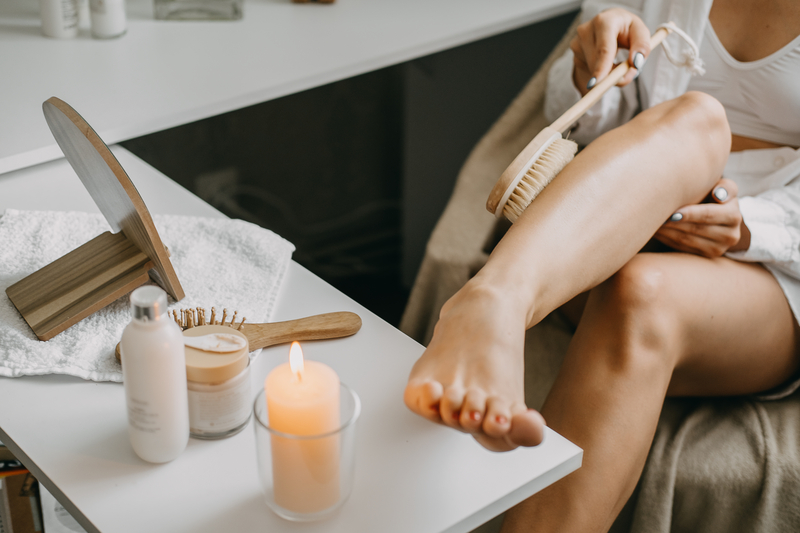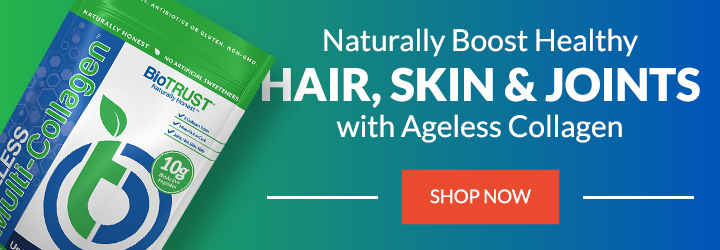Dry Brushing: Benefits, Downsides & How to Get Started

With spring and summer arriving in North America, many of us are beginning to bare our skin again—no longer hiding under our winter coats. In other words, it’s time to prep the skin to look its best. Some popular options include collagen supplements, “slugging” (i.e., slathering on a heavy duty occlusive like Vaseline or ceramide creams), simplified skincare routines, and of course, dry brushing (aka body brushing).
What is Dry Brushing?
If you aren’t familiar with the technique, dry brushing makes use of a stiff yet soft bristled brush to sweep over the body to help remove dry, flaky skin and improve circulation. It’s called dry brushing as it’s used before showering or getting the body wet. That is, before getting into the shower, starting at the toes, you’ll brush your way up your body using gentle, upward or circular motions.
While dry brushing has become trendier in recent years, it’s actually an ancient practice. It’s a regular practice in Ayurvedic and has been used throughout history to enhance beauty and cleanse the skin from ancient Greece to Japan.
Dry brushing is done as part of a pampering package in day spas, but it’s also very easy to do at home as part of your self-care or beauty routine.
Benefits of Dry Brushing
As with many beauty trends, dry brushing does have its benefits; however, some may be overstated. Here are those that have been well-demonstrated:
• Exfoliates the skin: The stiff brush bristles help remove dry, flaky skin, removing the dull layer that builds up. After a dry brushing session, the skin feels smoother and softer and tends to look fresher and brighter, giving you a healthy glow.
Dry brushing is also gentler on the skin than using a scrubbing product or cloth in the shower as hot water can inflame the skin, strip away healthy oils, and make the skin dryer.
• Enhances circulation: Dry brushing brings the blood to the skin’s surface and helps enhance circulation, which can help the skin look more glowing, at least for a little while.
• Helps energize and invigorate the body: Likely because of the enhanced circulation and because it feels nice (as long as you don’t brush too vigorously), many people feel energized and more vibrant after a brisk dry brushing session. Dry brushing may also help stimulate the nervous system, which is why some people prefer to dry brush in the morning for an energy lift, rather than close to bedtime as it may keep you awake.
• May reduce the appearance of cellulite (temporarily): By helping plump up the skin with blood, dry brushing may make cellulite look less prominent. That said, it doesn’t actually reduce cellulite or help the body redistribute fat, so the effect is temporary at best.
Some people also just like the way it feels. It’s a form of self-care that helps you both relax and energize, which is a benefit in and of itself.
There are other claimed benefits of dry brushing that have little to no evidence and are likely overstated, if not completely false. For example, there’s little (or even no) evidence that dry brushing…
• Stimulates the lymphatic system: Lymph is a clear fluid found throughout the body as part of the lymphatic system, which is an important part of the immune system. There have been some claims that dry brushing not only stimulates circulation but that it helps move sluggish lymph. However, there is no research confirming it actually has this effect.
• Detoxifies the body: Toxins are removed from the body primarily by the liver and kidneys, not the skin. While it’s been suggested hot yoga, exercising, and sauna bathing can help the body sweat out toxins through the skin, the evidence isn’t always there. And there’s also little to suggest that dry brushing can help eliminate toxins, despite some claims. However, it may help unclog pores and improve blood flow, at least temporarily, so it doesn’t hurt.
• Aids digestion: The skin also isn’t involved in digestion, so dry brushing would have little ability to affect digestion. You may be able to help ease mild constipation by gently massaging the abdomen, but there are better ways to help food move more easily through the digestive system.
Downsides of Dry Brushing
While dry brushing is typically very safe, there are times when you will want to avoid it to support skin health. For instance, dry brushing can…
• Irritate skin, especially when it’s done too vigorously, too often, or over sensitive flesh. The skin should look only slightly pink after dry brushing. It should never look red or leave cuts or abrasions, which can open the body up to infection.
• Dry out the skin: It is important to rinse off the dead skin after dry brushing and then generously apply a moisturizing lotion or oil after a session.
• Further damage injured skin: If you have a sunburn, rash, wound, or skin issues like eczema, psoriasis, or rosacea, skip dry brushing until or only when skin is healthy. If you find that dry brushing is irritating the skin, give your skin a break, and then reduce the frequency and pressure if you decide to try it again in the future. If your skin is too sensitive, it may just not be right for you.
Also avoid dry brushing over moles, warts, or raised bumps. Dry brushing doesn’t help remove the skin’s character, but it could damage it. If the skin becomes inflamed or irritated, stop immediately.
How to Get Started Dry Brushing
1. Choose the right brush
The first step to dry brushing is choosing your equipment. Brushes are pretty easy to find at local beauty supply stores, health food stores, and online. And they can even be found at some of the larger box stores in the skincare section.
Look for a natural bristle brush made from jute, sisal, or cactus fibers that’s stiff yet soft to the touch. (Other options include boar and goat hair.) Remember, you don’t want to hurt your skin, and it shouldn’t be painful or even uncomfortable to dry brush. So, avoid brushes with super hard or stiff bristles. If brushes are too harsh for your sensitive skin, you may choose to dry “brush” with a soft, dry wash cloth.
There are handheld versions that are easier to wield as well as those with a longer wand that makes it easier to reach the back, shoulders, and back of the legs. Some offer removable handles, so it’s easier to dry brush all areas of the body. You may need to try some different options to find your favorite.
If you want to dry brush your face, that requires a smaller, even softer brush or a soft washcloth as the skin on the face and neck is more delicate.
2. Clean your dry brush
An unclean brush can increase the risk of infection, so avoid sharing your brush with others and keep it clean. Most brushes come with cleaning and care instructions. If not, you’ll want to ensure your brush is kept clean by washing it well with a gentle soap, rinsing well, and then allowing it to dry completely. Make sure it’s completely dry before each use, though you can use a touch of oil on the tips of the bristles if you choose.
To make sure the bristles are sanitized, you can also rub them with a cloth dampened with rubbing alcohol.
3. Choose your location
Now that you have your clean dry brush, the rest is easy. Start by removing your clothing and step into your bathtub, shower, or just onto your shower mat where you can be relaxed and comfortable yet won’t slip. Before getting started, you’ll also want to make sure your body is completely dry.
4. Work your way up the body
Using light, long, gentle strokes, start at your toes and work your way up your body toward your heart, finishing with your feet, up your calves, onto your thighs, and then over the butt, back, belly, and chest. The belly and chest may be more sensitive, so make sure to use an even more gentle touch. Don’t skip the back of the hands and arms, starting at the fingers and working up to the shoulders.
Remember, you aren’t scrubbing pots and pans or your bathtub. You’re gently stroking your skin, which should look glowing afterward, rather than red or scratched. You can use a bit more pressure on the tougher skin of the knees, elbows, ankles, and bottoms of feet and a bit less for more delicate or sensitive areas.
If you can’t comfortably reach any specific areas, it’s okay to bypass them. Most of the body (such as the legs and arms), you’ll use light upward strokes, but you can also use circular strokes in some areas (like the back and torso). Skip over areas that are especially sensitive, such as the breasts and especially nipples.
Dry brushing shouldn’t take a lot of time—less than five minutes. Don’t linger too long on any body part or hit any areas more than a couple of times.
**Note on dry brushing the face: If you do choose to dry brush the face, remember to use a brush designed for this more delicate skin. These brushers are smaller, softer, and intended to be used even more gently. Continue using the same upward or circular method starting from the bottom of the neck. You can also choose to use a dry washcloth rather than a brush for this step to help avoid irritating the skin.**
5. Rinse off
Once you’re done dry brushing, rinse off any dead skin in the shower or bath. You may want to use a moisturizing body wash as well, but avoid any that contain a scrub or another exfoliant or harsh soaps or acne washes as your skin will be more sensitive than usual. You’ll also want to avoid using mechanical exfoliants like sponges or loofahs.
6. Moisturize
When you hop out of the shower, gently pat the skin dry, rather than rubbing it. Finally, one of the most important steps after dry brushing is to make sure you generously apply your moisturizing lotion, balm, or oil.
7. Repeat as necessary
Some people prefer to dry brush daily; others prefer two to three times a week, weekly, or just when they feel like their skin needs it. Remember not to dry brush if your skin is already sensitive or irritated or if you’re battling a skin condition. Many people suggest to dry brushing in the morning as the practice can be energizing and invigorating, helping jumpstart the day. But you can also dry brush in the afternoon or evening if you prefer.
You brush your hair, teeth, and perhaps brows or beard, so why not brush your skin? This ancient “healing” ritual may not live up to all of the fantastic claims, but it still offers some benefits, including smoother, softer, more glowing skin and a moment of feel-good self-care that can help you reenergize for your busy day.





 7 Signs Your Body is Seriously Low on Collagen (not just wrinkles)
7 Signs Your Body is Seriously Low on Collagen (not just wrinkles) Health Expert: "Turmeric Doesn't Work (unless...)"
Health Expert: "Turmeric Doesn't Work (unless...)" 3 Warning Signs Your Probiotic Supplement is a Total Waste
3 Warning Signs Your Probiotic Supplement is a Total Waste

